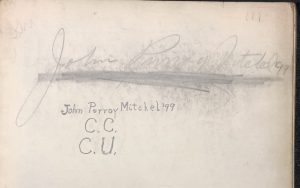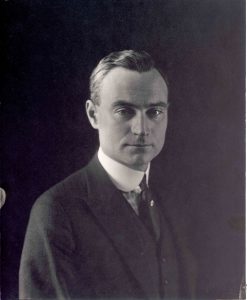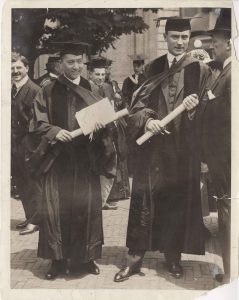We recently processed a small of collection of notebooks, essays, and exam books by John Purroy Mitchel, Columbia College Class of 1899. Mitchel’s time at Columbia was in the midst of major changes: he started as student at Columbia College on 49th Street and was part of the second class to graduate from Columbia University in Morningside Heights.
The small collection of school materials includes John Purroy Mitchel’s English 16 notebook. As a junior, Mitchel was a student in Professor Brander Matthews’s American Literature course in the fall of 1897. This was the first semester of classes on the brand-new Morningside campus and with the school’s recent designation as Columbia University. In the inside of the notebook, an early adapter to the new terminology, Mitchel identifies himself as “John Purroy Mitchel ’99 C.C. C.U.” He is using the new name of the undergraduate college, Columbia College (formerly the School of Arts), in the newly renamed Columbia University.

The English 16 lectures covered a wide range of American authors in chronological order. For each author, students learned some biographical information, their major works, the work’s reception and influence. For Harriet Beecher Stowe, Mitchel notes that she is the “only woman who in this country has written a book of cosmopolitan reputation. Uncle Tom’s Cabin is the only book written in this century which has had this worldwide reputation.” After a short biographical sketch (birth, marriage, early works, and publication numbers), Mitchel notes that Stowe’s work “was looked upon as a bible upon the South … strength of her book comes from the fact that she tried to tell the truth and did not try to make slavery appear horrible and did not try to calumniate the slave owners.” Her book “made people think about slavery and had great weight in changing the sentiment between ’52 and ’56.” This lesson is followed by Lincoln, whose Gettysburg speech “is the finest piece of prose written on this continent.”

At the time, the Civil War was very much on campus minds. A few months before these lectures, in April 1897, was the dedication of Grant’s tomb just blocks away from the new campus. And a few months later, in May 1898, the University published a pamphlet, War Records, listing the graduates and students of Columbia who served in the army and navy during the Civil War. For Mitchel, the War was also personal. His father, James Mitchell, and his two brothers were from Virginia and fought for the Confederate Army. James served on the staff of Stonewall Jackson. The two brothers died in the war and James lost an arm.
After graduation, Mitchel went to law school at NYU. He is perhaps best remembered as the “Boy Mayor,” since he was elected Mayor of New York (1914-1917) at the age of 34. He died shortly after his mayoral term during a WWI military training flight with the Air Service in Louisiana on July 6, 1918. A gift of the Class of 1899, the John Purroy Mitchel memorial plaque was unveiled in 1921 on the west side of Hamilton Hall.
